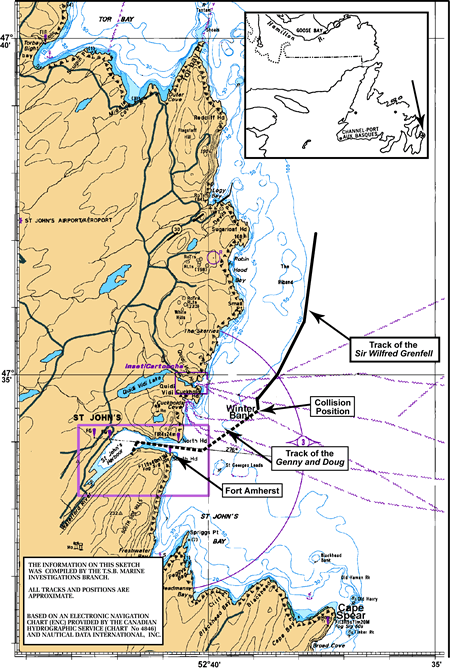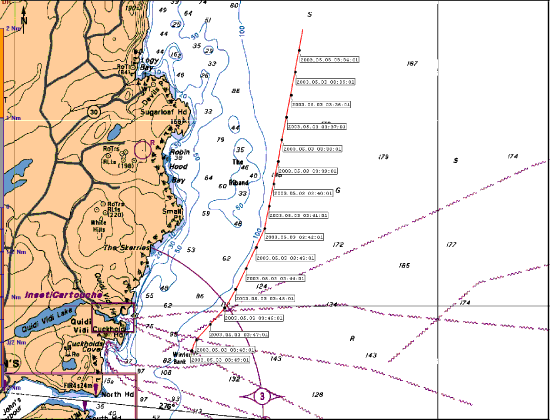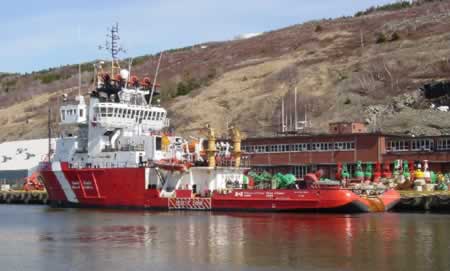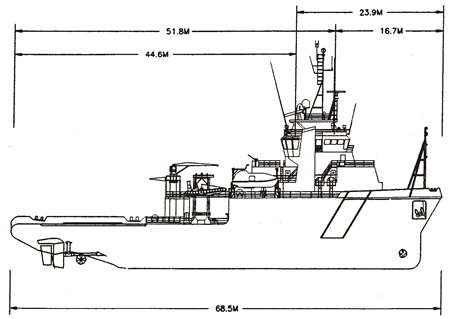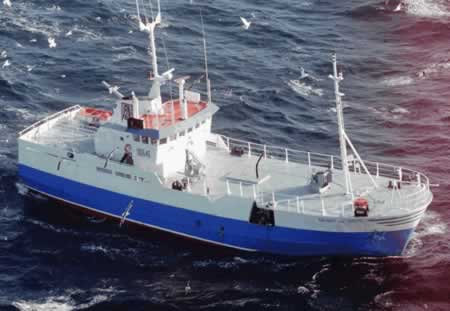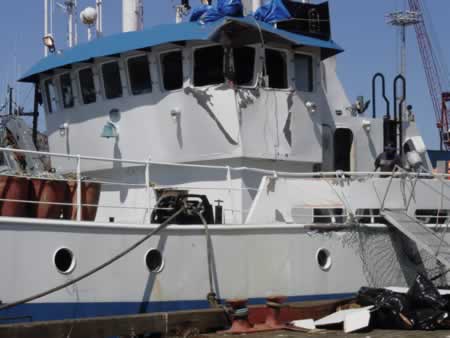Collision
Between the Canadian Coast Guard Ship
Sir Wilfred Grenfell
and
the Fishing vessel Genny and Doug
Outside St. John's Harbour
Newfoundland and Labrador
The Transportation Safety Board of Canada (TSB) investigated this occurrence for the purpose of advancing transportation safety. It is not the function of the Board to assign fault or determine civil or criminal liability. This report is not created for use in the context of legal, disciplinary or other proceedings. See Ownership and use of content. Masculine pronouns and position titles may be used to signify all genders to comply with the Canadian Transportation Accident Investigation and Safety Board Act (S.C. 1989, c. 3).
Summary
In the early morning hours of 03 May 2003, the Canadian Coast Guard Ship (CCGS) Sir Wilfred Grenfell was returning to St. John's after conducting engine trials just outside the harbour. At 0054 Newfoundland and Labrador daylight time, the fishing vessel Genny and Doug departed the dock in St. John's Harbour and proceeded outbound en route to the fishing grounds. The two vessels collided 1.4 nautical miles northeast of the harbour entrance in thick fog. There was extensive damage to the wheelhouse and hull on the port side of the Genny and Doug, and minor damage to the CCGS Sir Wilfred Grenfell's bow. Following the collision, both vessels returned to port where the Genny and Doug underwent repairs.
Factual information
Particulars of the vessels
| Name | "Sir Wilfred Grenfell" | "Genny and Doug" |
|---|---|---|
| Official number | 809762 | 808324 |
| Port of registry | Ottawa, Ontario | St. John's, NL |
| Flag | Canada | Canada |
| Type | Search and Rescue | Fishing |
| Gross tonsFootnote 1 | 2403 | 346 |
| Length | 68.5 m | 28.5 m |
| Draught forward | 5.5 m | 2.29 m |
| Draught aft | 5.62 m | 3.05 m |
| Built | 1987, Marystown, NL | 1987, Pictou, Nova Scotia |
| Propulsion | 2 x Deutz SBV16M-628 and 2 x Deutz SBV9M-628 driving 2 controllable-pitch propellers at 12 860 brake horsepower (9590 kW) | 1 x 625 brake horsepower (466 kW) fixed propeller |
| Cargo | nil | 23 t of frozen bait |
| Crew | 18 | 13 |
| Owners | Fisheries and Oceans Canada/Canadian Coast Guard | Funk Island Banker Ltd. |
Description of vessels
The CCGS Sir Wilfred Grenfell is a Canadian Coast Guard search and rescue vessel of welded steel construction, similar in design to an offshore supply vessel. The vessel is equipped with a bow thruster, stern thruster and four engines driving twin screws, which enable it to maintain a speed of 15 knots.
The Genny and Doug is a longliner of welded steel construction. The wheelhouse is located about two-thirds of the way aft from the bow. The vessel is fitted with one engine and single screw, and has a maximum speed of about 10 knots.
History of the voyage
The CCGS Sir Wilfred Grenfell departed St. John's in the early afternoon hours of 02 May 2003, to conduct engine trials outside the harbour. The second mate came on watch at midnightFootnote 2 along with a lookout and a helmsman. The visibility was poor due to fog, and the vessel's fog signal was reportedly sounded in accordance with the Collision Regulations. Around 0030, 03 May 2003, the officer of the watch (OOW) received a call from the engine room informing him that the trials had been completed and the vessel could head into port. The OOW relayed this information to the master, who came up to the wheelhouse and instructed him to head toward St. John's. The master, aware of the operational environment, then proceeded below deck. In accordance with the Vessel Traffic Services Zones Regulations, the OOW contacted St. John's Marine Communications and Traffic Services (MCTS) on the very high frequency (VHF) radio and reported that the CCGS Sir Wilfred Grenfell was abeam Torbay Point (approximately seven miles from the entrance to the harbour at call point 2N) at 0055. The master was not on the bridge and the vessel was proceeding at a speed of approximately 15 knots.
The Genny and Doug contacted St. John's MCTS at 0054, May 3, informing them that it was departing Pier 19 in St. John's Harbour, bound for the fishing grounds off Newfoundland. This call was made seconds before the CCGS Sir Wilfred Grenfell's initial call to St. John's MCTS. The master had the conduct of the vessel as it pulled away from the dock, and the conduct was then handed over to the mate. A deckhand was on watch in the wheelhouse acting as lookout. There was conflicting information as to whether the fog signal was sounded. The officers on the bridge were aware from MCTS communications that the CCGS Sir Wilfred Grenfell was inbound. On arrival at the entrance to the harbour, they identified the vessel on their radar at a distance of about 3.5 miles. The Genny and Doug checked in with St. John's MCTS at 0108 and reported that its position was abeam Fort Amherst, at the entrance to the harbour. After clearing the entrance to the harbour, the OOW set a course of 049 True. At 0115 the OOW mistakenly called the CCGS Sir Wilfred Templeman on the radio to arrange a port-to-port passage; the OOW believed that this was the vessel referred to in the MCTS communication. MCTS contacted the Genny and Doug and informed them that the correct name of the vessel was Sir Wilfred Grenfell, and that the vessel would soon be arriving at the checkpoint, at a radius of two miles from the harbour entrance. The Genny and Doug did not call the Sir Wilfred Grenfell. Some time after passing Fort Amherst, the captain went below to inform the crew about their watches and returned to the bridge about two minutes later. The Genny and Doug was proceeding at a speed of approximately 6 knots.
About two miles from the entrance to the harbour, just after 0116, the CCGS Sir Wilfred Grenfell checked in with St. John's MCTS and switched the radar from a six-mile range to a three-mile range. In acknowledging the call, MCTS advised the CCGS Sir Wilfred Grenfell that the Genny and Doug had passed Fort Amherst at 0109. The OOW acknowledged the message. The OOW manually adjusted the anti-clutter controls in an attempt to alleviate the clutter on the starboard side of the display, but did not see the Genny and Doug on the radar. At 0117, the Genny and Doug contacted the CCGS Sir Wilfred Grenfell on the VHF radio, and the OOWs on the two vessels communicated with each other for the first time. The OOW on the Genny and Doug relayed that he was altering course to starboard in order to give the vessels more room to pass port-to-port, and steadied up on a course of about 090° True. The OOW on the CCGS Sir Wilfred Grenfell acknowledged this communication and picked up the Genny and Doug on the radar for the first time, at approximately one-half mile.
Realizing the vessels were converging quickly, the OOW on the CCGS Sir Wilfred Grenfell immediately slowed the vessel down and gave the helmsman a starboard helm order. When the vessel did not respond as expected, he queried the helmsman as to whether the helm was to port. Some confusion ensued as to what helm order was requested and the helmsman applied port wheel. Seconds later, the port side lights and masthead light of the Genny and Doug were visible through the fog on the starboard bow. At the same time, the master of the Genny and Doug saw that the CCGS Sir Wilfred Grenfell was coming right for them. There was no time for further collision-avoidance measures by the Genny and Doug. The OOW of the CCGS Sir Wilfred Grenfell put the pitch full astern to avoid a collision. At 0119, the bow of the CCGS Sir Wilfred Grenfell came in contact with the port side of the Genny and Doug in way of the superstructure. The collision occurred at 47°34′30″ north and 52°39′05″ west.
After the initial impact, secondary contact was made in way of the shell plating further aft, near the waterline on the Genny and Doug. The collision caused extensive damage to the wheelhouse and lesser damage to the shell plating on the port side of the Genny and Doug. The CCGS Sir Wilfred Grenfell sustained a minimal amount of damage to her bow, comprising small dents and scratches. There was no injury and no pollution. The wind was from the southeast at 5 to 10 knots and the visibility was less than one-half mile.
Following the collision, both vessels took all way off and the crew of the Genny and Doug donned immersion suits, sounded their tanks and checked compartments for any ingress of water. The master of the CCGS Sir Wilfred Grenfell arrived on the bridge after the collision and instructed the crew to sound their tanks and prepare the rescue boat for launching. No ingress of water was detected in either vessel. After confirming with each other that neither vessel was taking on water, and ensuring that St. John's MCTS had been monitoring the events as they occurred via the VHF, both vessels returned to port to further assess damage.
Certification and experience
CCGS Sir Wilfred Grenfell
The master of the CCGS Sir Wilfred Grenfell held a Master Mariner's Certificate, which was issued in 1996 and endorsed pursuant to the Convention on Standards of Training, Certification and Watchkeeping for Seafarers 1995 (STCW 95) in 2001.
The second mate held a Watchkeeping Mate's Certificate issued in June 2000, and an STCW 95, which was endorsed in 2002. His experience as a ship's deck officer consisted of approximately 16 months sea time over a two-year period on board a cruise ship, and about seven months sea time with the Canadian Coast Guard. Most of his Coast Guard sea time was spent on board the CCGS Sir Wilfred Grenfell.
The helmsman held a Bridge Watchman's Certificate issued in 1989 and an STCW 95 endorsement issued in 2002, as required under the Coast Guard's Safety Management System and the Training Standard.Footnote 3 He had worked for the Coast Guard off and on for about five of the last 10 years on different vessels and was an experienced helmsman. He joined the CCGS Sir Wilfred Grenfell three days prior to the collision and his experience at the wheel of this particular vessel consisted of about ten minutes, which he had acquired the previous day.
The lookout held a Bridge Watchman's Certificate and an STCW 95 endorsement, both of which were issued in July 2002. He also held a Watchkeeping Mate's Certificate issued in 1987. He had been working at sea intermittently for the past thirty years, and with the Coast Guard since 1996. He joined the CCGS Sir Wilfred Grenfell three days prior to the collision.
Genny and Doug
The master of the Genny and Doug held a Fishing Vessel Master Certificate issued in 1970 and a Continued Proficiency endorsement issued in 2003. He had been fishing on various vessels for 38 years.
The mate held a Fishing Master Class 3 Certificate issued in 1993 and a Continued Proficiency endorsement issued in 2003. At the time of the occurrence, he had been mate on the Genny and Doug for 10 years.
The lookout held no certification and was not required to do so by regulations. He had served as a deck hand on board fishing vessels for several years, serving the last 12 to 14 years with the same master.
Navigational equipment
The navigational equipment in use on the CCGS Sir Wilfred Grenfell included two ARPAFootnote 4 radars that were interfaced with Global Positioning Systems (GPS), two VHF radios, and an Electronic Chart System (ECS).
The starboard radar was an X-band radar, which operates at a wavelength of 3.2 cm and offers better detection of small targets and better resolution than the S-band. The starboard radar was used as the primary radar the morning of the occurrence. Reportedly, more clutter was observed on the radar than was expected with the weather conditions at the time. The OOW adjusted the anti-clutter controls, but he was unable to resolve the radar image satisfactorily. A post-occurrence technician's report showed the radar to be in good working order.
The port radar was an S-band unit, which operates at a 10 cm wavelength and is used primarily for long-range detection of targets offshore; it was located on the port side of the bridge. Upon inspection after the collision, an electronic technician confirmed the ship's reports that the radar would not tune properly. Despite several service calls since the radar was new, this was a frequent recurring problem with this radar. An S-band radar is not generally used as the primary radar close to land, as an X-band radar offers greater resolution and detection of smaller targets. The port radar was unreliable and was not used by the ship's complement as an aid to navigation.
The ECS is a navigational device that is integrated with the radar, the GPS and the Gyro compass. The vessel's progress can be monitored on an electronic chart with a radar overlay. This system also provides a recording and playback feature that can be used to recreate a vessel's course and speed with precision (see Figure 2).
Safety Management System
The CCGS Sir Wilfred Grenfell was certified under the International Safety Management (ISM) Code and, as such, had a safety management system (SMS) in place. The primary objectives of the ISM Code are to ensure safety at sea, prevention of human injury or loss of life, and protection from damage to the environment. The ISM Code is designed to promote safety through the adoption of best practices established by the international rules and regulations, codes, guidelines and standards recommended by the IMO, the flag states and various maritime .industry organizations. Checklists were in place for various procedures and scenarios, such as procedures for pre-arrival into port and operating in restricted visibility. However, as a non-SOLASFootnote 5 vessel, the CCGS Sir Wilfred Grenfell was not required to comply with the ISM Code.
The Safety Management System on this vessel required the commanding officerFootnote 6 to promote and implement a bridge resource management (BRM) philosophy. A BRM philosophy emphasizes the importance of teamwork, information exchange and coordination among bridge team members.
Speed
The speed of the CCGS Sir Wilfred Grenfell prior to the collision, as obtained from the ECS recording, showed that the vessel was proceeding at a sustained speed of 15 knots until two minutes prior to the collision. At one minute before the collision, it was proceeding at a speed of 11 knots and, at the time of the collision, at about 6 knots.
The maximum speed of the Genny and Doug was about 12 knots. Throughout the trip, it was proceeding at a speed of approximately 6 knots.
The conduct of a vessel at sea is governed by the Regulations for the Prevention of Collisions. In determining a safe speed, a navigator is required to take into consideration a number of factors, including the following:Footnote 7
- the state of visibility;
- the traffic density, including concentrations of fishing vessels or any other vessels;
- the characteristics, efficiency and limitations of the radar equipment, and
- the possibility that small vessels may not be detected by radar at an adequate range.
Emergency manoeuvre tests performed during the sea trials of the CCGS Sir Wilfred Grenfell indicated the vessel could achieve a crash stop (full ahead to full astern) in 53 seconds while travelling a distance of 210 m. The maximum speed attained during these trials was 15.5 knots.
Radio communications
Under the Vessel Traffic Services Zones Regulations, participation in the Vessel Traffic Services system is compulsory for larger vessels, which are required to maintain radio watch on the designated VHF frequency. One of the primary functions of the MCTS is to provide participating vessels with traffic and waterway information. This information is typically provided whenever a vessel reports in at a calling-in point.
St. John's MCTS monitors VHF radio channel 11 for vessels transiting the harbour and approaches. Tape recordings of all communications are kept. Vessels contact the MCTS at various call-in points and are provided with vessel traffic information in the area. Vessels approaching the north call in at 2N off Torbay Point and then two miles from the entrance to the harbour. The Genny and Doug first contacted MCTS at 0054 to inform them of their imminent departure. This communication was immediately followed by a call from the CCGS Sir Wilfred Grenfell, informing the MCTS that the vessel was on its way back to St. John's.
At 0108, the Genny and Doug checked in with St. John's MCTS on the VHF at Fort Amherst.
The OOW of the Genny and Doug had been monitoring radio communications between MCTS and other traffic, and at 0115 made a call to the CCGS Sir Wilfred Templeman requesting a port-to-port passage. Recognizing the error in the transmission, MCTS contacted the Genny and Doug immediately and informed the crew that the correct name of the vessel was the CCGS Sir Wilfred Grenfell. The Genny and Doug acknowledged the message. At 0116, the CCGS Sir Wilfred Grenfell called MCTS to report that it was at the two-mile call-in point. The MCTS replied that the Genny and Doug had passed Fort Amherst at 0109, and the CCGS Sir Wilfred Grenfell acknowledged the transmission. Immediately afterwards, at 0117, the Genny and Doug contacted the CCGS Sir Wilfred Grenfell and informed the crew that it was altering course to the east. The CCGS Sir Wilfred Grenfell acknowledged this transmission, and the next communication occurred immediately following the collision at 0119.
St. John's MCTS does not have the capability to monitor vessel traffic by radar.
In spite of the restricted visibility, neither vessel made a navigation safety call prefixed SECURITY on VHF radio channel 16, to alert traffic in the area to their presence.
Analysis
Radio communications
The transmissions by the Genny and Doug from within St. John's Harbour would likely not have been heard by the OOW of the CCGS Sir Wilfred Grenfell, and the response by MCTS provided listeners with limited information pertaining to the departure of the fishing vessel. The OOW of the CCGS Sir Wilfred Grenfell was aware of MCTS procedures and initiated the call-in immediately following that of the fishing vessel. The OOW ought to have been aware that the Genny and Doug was departing the berth in St. John's Harbour. However, no attempt was made by the OOW of the CCGS Sir Wilfred Grenfell to contact the vessel to ascertain its position, confirm its intentions, and/or to arrange a safe passage.
The OOW of the Genny and Doug meant to call the CCGS Sir Wilfred Grenfell at 0115, but mistook the name as the Sir Wilfred Templeman. Although St. John's MCTS corrected the Genny and Doug, no follow-up calls were made until two minutes before the collision.
Although the OOWs of the two vessels knew that a potential converging situation existed, neither vessel made its intentions known to the other in a timely manner to arrange a safe passage, nor did they take appropriate measures in ample time to avoid collision.
Bridge operating practices and procedures
Effective Use of navigational equipment
The OOW of the CCGS Sir Wilfred Grenfell was primarily monitoring the starboard (X-band) radar during the time leading up to the collision. Despite manipulating radar controls, the OOW was unable to pick up the fishing vessel on the radar until both vessels were about one-half mile apart.
However, a post-occurrence technician's report showed the radar to be in good working order. No defects or deficiencies in the radar had been reported by the ship's personnel prior to the collision. Considering the light winds, low sea state and limited precipitation in the form of fog, the fact that the OOW did not pick the Genny and Doug up on the radar screen suggests that either the radar was not adjusted for optimum performance, or that it was not monitored closely.
The port (S-band) radar was not being used. The problems associated with poor target response from this radar were known to have existed, off and on, for a long period of time. Consequently, information obtained from the radar could not be relied upon. This effectively negated its use, especially in poor-visibility conditions.
The OOW of the Genny and Doug was monitoring one of the vessel's two radars and had picked up the CCGS Sir Wilfred Grenfell after clearing the entrance to the harbour. From the information available, he was able to determine that a close-quarters situation existed with the CCGS Sir Wilfred Grenfell and attempted to alleviate this by means of a call on the VHF and an alteration to starboard of about 40° about two minutes prior to the collision.
Conduct of navigation
The two vessels were steering near reciprocal courses in a near head-on situation when the Genny and Doug cleared the Narrows. The OOW of the CCGS Sir Wilfred Grenfell should have been aware of the presence of the fishing vessel from the time the fishing vessel departed from the wharf, some 22 minutes prior to the collision. However, the fishing vessel was not picked up on the radar screen until the vessels were about one-half mile apart - a steaming time of less than two minutes. Given that the CCGS Sir Wilfred Grenfell was operating in visibility of about one-half mile, the OOW ought to have established VHF contact and reduced his speed in accordance with good seamanship practices. On the other hand, the fishing vessel was monitoring the progress of the CCGS Sir Wilfred Grenfell and did not give it a wide berth at an early stage. This situation indicates that both vessels failed to take reasonable measures to ensure safe navigation, consistent with the environment in which they were operating.
Bridge crewing in restricted visibility
Consistent with good seamanship practices and Bridge Standing Orders, the CCGS Sir Wilfred Grenfell commanding officer was notified when the vessel encountered restricted visibility and again when the vessel was cleared to return to port. During the commanding officer's last visit to the bridge prior to the collision, he communicated briefly with the OOW and then proceeded below deck. The OOW was left in charge of the bridge until the commanding officer's return following the collision. This situation occurred despite the fact that the OOW had limited experience being in charge of a navigation watch or operating a vessel in restricted visibility. Furthermore, the vessel was operating in proximity to land and the harbour entrance. This situation presented risks that might have been mitigated by the commanding officer's presence on the bridge at a critical phase of the voyage.
The captain of the Genny and Doug remained on the bridge from the time of departure from the dock until the time of the collision, with the exception of a two-minute interval when he went below decks to assign watches to the crew. At the time of collision, the OOW and a watchman were also present in the wheelhouse.
Implementation of BRM
Although the safety management system on the Sir Wilfred Grenfell embraced the BRM philosophy, it was not fully implemented. To do so would have required the bridge to be crewed by an experienced officer and the navigation team to be composed of personnel who could share the workload. This would not have placed the OOW in the precarious situation of working in isolation without the synergy of the team. Furthermore, it would have provided an opportunity for discussion of the vessel's speed, traffic in the vicinity, and the sharing of workload, including monitoring the execution of the helm orders - all of which would have provided an opportunity to mitigate the risks at this safety-critical phase of the voyage.
As is the case with most fishing vessels, the Genny and Doug, having only the captain and the mate, had neither a formal safety management system or BRM in place. However, the captain, the OOW and a watchman were on the bridge sharing the workload and working as a team.
Coast Guard procedures and practices
The CCGS Sir Wilfred Grenfell's International Safety Management checklist for navigating in restricted visibility was entered in the log as completed by the chief mate before midnight, in accordance with coast guard directives. Before handing over the watch, the chief mate related to the second mate that the master had been made aware of the restricted visibility, the fog signal was sounding and they had discussed the known traffic in the area. The checklists are intended as aide mémoires to help ensure that all elements essential to the task, in accordance with established procedures and practices, have been considered, thereby augmenting safety. The navigation in restricted visibility checklist included the following:
Proceed at a safe speed appropriate to the circumstances
The speed of the CCGS Sir Wilfred Grenfell was determined to be 15 knots right up until two minutes before the collision. The OOW of the CCGS Sir Wilfred Grenfell did not begin to slow the vessel down until after he was contacted by the Genny and Doug for the first time. At this stage, the vessels were one-half mile apart, some two minutes before the collision.
Navigating a vessel in the proximity of the harbour entrance at 15 knots in restricted visibility under the circumstances noted cannot be considered a safe speed.
Maintain a careful radar watch, check for optimal performance and detection
Optimal performance of the radar can only be determined by reviewing the information on the radar screen in relation to the objects in the area. The presence of the fishing vessel ought to have been known, but it was not picked up on the radar screen.
Maintain a careful radio watch, and broadcast Security call, if necessary
Given that the vessel was operating in fog at the entrance to the harbour and that the radar performance was less than optimal, the broadcast on VHF 16 of a security message would have alerted vessels in the area to its position. However this was not done.
Implementing the established procedures as set forth in the checklists would have helped to mitigate the risks.
Procedures and practices on the Genny and Doug
The personnel in the wheelhouse of the Genny and Doug at the time of the collision consisted of the captain, the mate and a seaman acting as lookout. When the mate took over the conduct from the captain after leaving the dock, the captain ensured that the mate left the steering in manual control until clearing the harbour entrance, which was his practice. The captain instructed the mate to call the CCGS Sir Wilfred Grenfell after passing Fort Amherst and ensured that he had done so again just prior to the collision. The two officers felt that it should have been a normal port-to-port passing, albeit a close one, given the Genny and Doug's late alteration of course to starboard and the CCGS Sir Wilfred Grenfell's failure to alter course to starboard. The Genny and Doug was travelling at 6 knots and was maintaining a radar watch, having picked up the CCGS Sir Wilfred Grenfell at Fort Amherst. The Genny and Doug's OOW made an unsuccessful attempt to contact the CCGS Sir Wilfred Grenfell by radio, but a prompt follow-up call to the CCGS Sir Wilfred Grenfell was not made following an intervention by the MCTS. Furthermore, Genny and Doug did not broadcast a security call on VHF 16.
Helm orders
When the OOW of the CCGS Sir Wilfred Grenfell became aware that a close-quarters situation was inevitable, the two vessels had already converged to within one-half mile of one another. At this critical juncture, he ordered the helmsman to alter course to starboard without indicating which course to steer or how many degrees of starboard helm to apply.
Internationally accepted procedures for issuing helm and steering orders include either giving the helmsman a course to steer or the exact angle of rudder sought. As the helm order was ambiguous, the helm execution was limited to five and ten degrees of starboard helm. When the OOW did not get the desired result of the vessel turning to starboard and given that the fishing vessel was nearby, he queried the helmsman as to whether the helm was to port. Some confusion ensued as to what helm order was requested and the helmsman applied port rudder, thereby turning the vessel to port. Furthermore, the helmsman did not repeat the OOW's order. The standard practice of repeating the orders is intended to ensure that helm orders are clearly understood, thereby reducing the chances of error. The necessity of doing so is stressed in the STCW 95 Bridge Watchman Training Course (TP 10936 E)Footnote 8 syllabus.
Using the standard practice to give helm orders and closely monitoring their execution would have helped to mitigate the risk of a wrong execution of the helm at a critical time in the vessel's passage. Furthermore, it would have provided the OOW with an opportunity to recognize the error at an early stage and allow for remedial measures.
As is typical on fishing vessels, most of the electronics and navigation tools on the Genny and Doug were centred around the console. As most fishing vessels are designed to be navigated by a single officer, the controls are usually within easy reach of the OOW. The OOW on the Genny and Doug was navigating the vessel stationed at the console. The Genny and Doug was steering under manual control until it reached Fort Amherst, where the OOW switched over to autopilot. The vessel was still on autopilot at the time of collision.
Findings
Findings as to causes and contributing factors
- While operating in reduced visibility, neither crew took appropriate measures in ample time to avoid collision.
- On the Genny and Doug no immediate attempt was made to contact the Canadian Coast Guard ship (CCGS) Sir Wilfred Grenfell following an earlier unsuccessful transmission, nor was a security call made.
- On the CCGS Sir Wilfred Grenfell, while operating at or near full speed, standard helm orders were not used and the execution of helm orders was not closely monitored, resulting in the vessel altering course into the path of the Genny and Doug.
- Bridge Resource Management principles were not fully implemented, resulting in the bridge of the CCGS Sir Wilfred Grenfell being insufficiently crewed with suitable personnel. The risks associated with operating a vessel in reduced visibility while approaching a port were not fully addressed.
Findings as to risk
- The port radar (S-band) on the CCGS Sir Wilfred Grenfell was not functioning properly for an extended period of time and was unreliable, thereby depriving the ship's complement of its use.
This report concludes the Transportation Safety Board's investigation into this occurrence. Consequently, the Board authorized the release of this report on .
